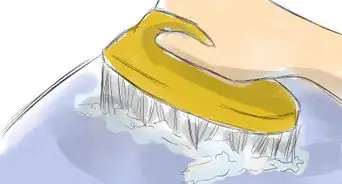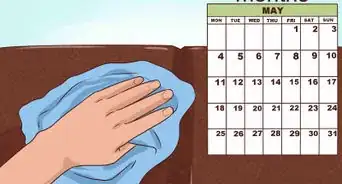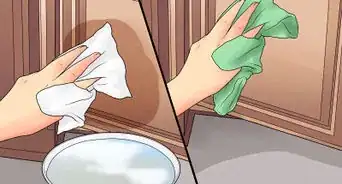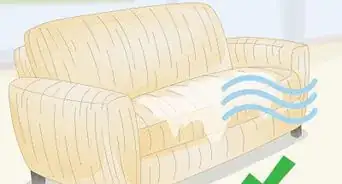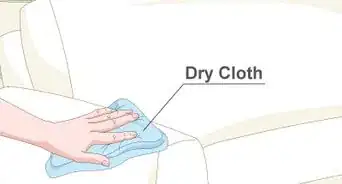This article was co-authored by Michelle Driscoll, MPH. Michelle Driscoll is the Owner of Mulberry Maids, which is based in Fort Collins, Colorado. With five years of experience, her business specializes in cleaning homes and small offices. She holds a Masters in Public Health from the Colorado School of Public Health. Additionally, Mulberry Maids has an A+ rating from the Better Business Bureau.
There are 15 references cited in this article, which can be found at the bottom of the page.
wikiHow marks an article as reader-approved once it receives enough positive feedback. In this case, 87% of readers who voted found the article helpful, earning it our reader-approved status.
This article has been viewed 348,587 times.
Keeping furniture clean not only makes the piece more attractive, but lengthens its lifespan immensely. While cleaning a whole house’s worth of furniture can represent a major undertaking, it doesn't have to be a hassle. In most cases, regular dusting and vacuuming in combination with semiannual deep cleans will keep your furniture looking fantastic.
Steps
Cleaning Upholstered Furniture
-
1Vacuum it. Regularly vacuuming your furniture is the easiest part of keeping your furniture clean. Make an effort to clean the cracks and crevices of your furniture between cushions, like the areas where the arms of a sofa meet the back. Take the cushions off, too, and vacuum all sides of them.
- The fiber density of microfiber furniture makes them stain-resistant, and lets the majority of dirt and debris be easily brushed loose. Give it a brushing before you vacuum.[1]
-
2Check the tags for guidance. If your furniture needs a solvent-based cleaner, you’ll want to purchase and utilize that; if your furniture calls for water-based cleaner, you can easily make that at home. If you no longer have the tag, consult a professional.[2]
- W means: Use water-based detergent.
- S means: Clean with a water-free product, like dry cleaning solvent.
- WS means: Either a water-based cleaner or a water-free cleaner is appropriate.
- X means: Professionally cleaning only, though feel free to vacuum it. Keep this is in mind when purchasing furniture.
Advertisement -
3Create a water-based cleaner at home with dishwashing liquid. Fill a spray bottle with water, then add a couple drops of dish detergent—liquid, not powder. A capful of white vinegar and a few pinches of baking soda in the mix will combat odor. Shake it up well.[3]
-
4Test the detergent mixture in an inconspicuous spot. Dip a sponge into the detergent mixture and rub some of it onto the back or underside of the upholstery - somewhere where it is not likely to be seen. Wipe the spot dry with a cloth and then let it air dry completely. If any discoloration occurs, don't use the detergent mixture. Consider instead having the furniture cleaned professionally.
-
5Dampen stains with a sponge. Use a sponge to rub your mixture into the furniture, and pat the upholstery dry with a cloth as you work. Allow the detergent to sit and penetrate for several minutes on any stains or tough spots.
-
6Blot future spills quickly.[4] The best way to avoid extensive cleaning sessions in the future is to act quickly when spills occur, treating them before they stain too severely. Always blot liquids, as opposed to scrubbing or rubbing. Vigorous movement can work the liquid further into the furniture at this stage, so the aim is to absorb as much liquid as possible before it soaks in.
Cleaning Leather Furniture
-
1Vacuum your furniture. Use the soft brush attachment when vacuuming the furniture to limit the risk of damaging it. As with upholstery, regular vacuuming will keep your furniture clean. Remove cushions to ensure you’re able to reach every nook and cranny in the piece of furniture.
-
2Use mild dish soap and water to clean dirt and minor stains. Mix about 1 to 2 tablespoons (15 to 30 mL) of mild dish detergent into a small bucket of warm water. Then, dip a clean cloth in the soapy water and wring it out so that the cloth is just damp. Next, wipe down the dirty areas of your furniture. Finally, pat the furniture dry with a clean cloth.
- Always start with the mildest cleaning solution, then use a stronger cleaner if the dirt or stain remains. If mild soap doesn't work, you can use vinegar.
-
3Clean your furniture with a vinegar mixture if soapy water doesn't work. In a bucket, mix equal parts vinegar and water. Soak a rag in the liquid, wring it out so that it’s damp but not soaked, and wipe down your furniture. Rinse out the rag often, to avoid spreading dirt, and follow back after your work with a dry cloth.[5]
- Equal parts lemon juice and cream of tarter is an ideal spot cleaner for white or beige furniture. Rub the mixture into the stain, and let it sit. After 10 minutes, wipe any residue away with a clean cloth.
- Rubbing alcohol, applied by cotton swab, works wonders for ink stains and mildew. Work it in, and then dry the area with hot air from a blow dryer.[6]
-
4Nourish the leather with vinegar and linseed oil. The mixture should be one part vinegar to two parts linseed oil. Shake it well, rub it in, and leave it for 10 minutes. Then, buff it out with a cloth. Multiple buffs may be required.[7]
- As another option, apply a leather cream to your furniture after you clean it to re-moisturize the leather.
-
5Keep leather out of the sun to avoid cracking and dryness.[8] Constant exposure to direct sunlight is bad for leather, even with diligent upkeep. Consider rotating armchairs or couches away from open windows, or ensuring that your blinds or drapes are closed when you’re not in the room.
- Keep leather furniture at least two feet away from heat sources in your home. Constant exposure can cause the leather to crack and age.[9]
Cleaning Wood Furniture
-
1Determine the finish used on your furniture. If you’re unsure, the correct procedure is beginning with mild cleaner, then moving successively toward stronger cleaning methods depending on the furniture’s reaction (or lack of one).[10] If you know that your furniture is stained, painted, etc., then you should employ a method appropriate to that finish.
- As a general rule for cleaning wood furniture: don’t use much water, and when you do, don’t leave it on the table for long. Water can cause the wood to warp and crack.
-
2Wipe dust and loose dirt from the wood. Use a clean cloth to go over the piece of furniture, loosening and removing any dust and dirt on the surface. Avoid feather dusters for wood furniture, as their quills can scratch wood. Instead, use cloth.[11]
-
3Remove dirt and stains using mild soap and water. Mix 1 to 2 tablespoons (15 to 30 mL) of mild dish detergent to a small bucket of warm water. Dip your cleaning cloth into the soapy water, then wring it out so it's just damp. Then, wipe the wood furniture down with the cloth. Next, dry the furniture with a clean cloth.
- Try mild soap and water before you use other cleaning products, as it's gentler. If the dirt or stains remain, clean the wood with mineral spirits.
-
4Rub the wood with mineral spirits if soap doesn't work. Mineral spirits, e.g., paint thinner, are excellent at wearing away accumulated grime. Pour the spirits into a rag, and gently rub your furniture. Work in a well-ventilated space when using mineral spirits. Wipe up any residual cleaner with a damp cloth. [12]
- Though safe for most wooden furniture, you should test an inconspicuous area (like an underside, or chair leg) to make sure your furniture doesn’t react poorly to the cleaner.
-
5Make a turpentine mixture for use on finished wood.[13] Mix three-quarters of a cup of boiled linseed oil and one-quarter of a cup of turpentine in a jar, and shake well. Both of these ingredients are readily available at hardware stores.
- As an alternative, commercial furniture oil is available for this same purpose.
-
6Work the turpentine mixture into the wood. Pour some on top of the table, then some onto a steel wool pad. Rub the mixture in along the grain. Once finished, polish with a soft rag. This mixture works very well on both finished and unfinished wood. It will increase the gloss and durability of finished wood, and it will prevent drying and cracking in unfinished wood. Rub the oil in thoroughly and allow the furniture to air dry.
- Using steel wool might sound severe, but the finish on most wooden furniture is thick enough to protect the wood itself from damage.
-
7Buff waxed or varnished surfaces with lemon oil.[14] Moisten a cloth, add a little oil, and wipe the piece down. Then, buff the surface, leaving little residue.
-
8Apply furniture wax to protect unwaxed furniture. Apply it generously with a cheesecloth, in the direction of the grain. Buff with a separate cloth afterward.[15]
Cleaning Acrylic and Lucite Furniture
-
1Use a clean cloth when you wipe it down. Acrylic and lucite require minimal care, but can be easily scratched by the little flecks of dirt and grime contained within a cloth you’ve been using to clean other furniture. Use a new—or newly laundered—cloth to wipe your furniture down to avoid scratches.[16]
-
2Avoid Windex and glass cleaners. As tempting as it might be when your furniture is clear, don’t use glass cleaner on acrylic furniture. Cleaners that aren’t designed for acrylic or lucite can crack your furniture.
- Similarly, if something gets stuck to your furniture, don’t use a solvent to remove it. Wet cloth and specifically designed cleaners only!
-
3Remove scratches with plastic polish. If your furniture has been scratched, the polish can actually repair the scratch, as well. Apply a small amount of plastic cleaner to the scratched surface, then gently buff the area with a soft cloth.
- Products designed to clean plastic are the only cleaners that should be used on acrylic furniture.
Cleaning Wicker Furniture
-
1Identify the material. “Wicker” refers to the technique used in the furniture’s construction, not to what it’s made from.[17] Your wicker furniture can be paper, rattan, or bamboo (among other possibilities), and there can be slight differences in the sort of care that each requires.
-
2Remove cushions. These will be cleaned separately from the furniture, and the manufacturer should list the proper methods on the tag. Ensure that you’re able to access every inch of the furniture’s surface.
-
3Use the brush attachment on your vacuum. Care must be taken to clean wicker furniture with gentle tools. Brushing your furniture regularly will help to keep it clean, and using the brush attachment on your vacuum performs double duty.
- For tough-to-remove dust, try using a soft paintbrush. For tough-to-reach dust, employ a toothbrush.[18]
-
4Softly brush Rattan and bamboo down with soapy, ammonia-containing water. Mix one part ammonia to two parts water in a bucket, then give it a good squirt of bleach-free dishwashing liquid. A brush is an ideal cleaning implement, but cloth can work.
- Ensure you're in a well-ventilated area before mixing chemicals, and use gloves when handling ammonia. Do not lean over the bucket.
- Bleach-free is important here. Ammonia and bleach together produces incredibly toxic fumes.[19] If you ever feel light-headed or nauseous while mixing your cleaners, get fresh air immediately.
- Wicker furniture should always be handled delicately, even during cleaning. Stiff brushes (and anything more abrasive) can cause extensive damage to your furniture and require the intervention of a professional.[20]
- For paper and grass wicker furniture, you can forgo the cleaning agents and simply wipe the pieces down with a damp cloth.[21]
- Wicker furniture only needs this thorough cleaning once or twice a year.[22]
-
5Place it outside in the sun to dry. It may take several days to entirely dry, but it’s of tantamount importance to entirely dry your wicker furniture. When wet, the cane, grass, and bamboo can slowly revert to their original (non-wicker) shapes.
- Wicker furniture must always be thoroughly dried, and care should be taken to avoid saturating it with water while cleaning.[23] Never sit on wicker that isn't dry.
- Wicker furniture should not, however, spend the entirety of its time in the sun. Chairs and tables that spend a lot of time in the sun should be rotated throughout the year to prevent the material from splitting.
-
6Keep it out of humid areas. Even though wicker "likes" humidity, the humidity will promote mold growth and shape distortion in wicker furniture.[24] Store your furniture in climate-controlled areas of your home if you'd like to maintain it longterm. Unless you live in the desert, the porch will not be kind to your wicker furniture.
- If you do live in the desert, though, give your wicker an occasional wipe-down with a damp cloth. Dry climes can, like direct sunlight, cause wicker to crack without proper care.
Expert Q&A
Did you know you can get expert answers for this article?
Unlock expert answers by supporting wikiHow
-
QuestionHow should I clean a down sofa?
 Michelle Driscoll, MPHMichelle Driscoll is the Owner of Mulberry Maids, which is based in Fort Collins, Colorado. With five years of experience, her business specializes in cleaning homes and small offices. She holds a Masters in Public Health from the Colorado School of Public Health. Additionally, Mulberry Maids has an A+ rating from the Better Business Bureau.
Michelle Driscoll, MPHMichelle Driscoll is the Owner of Mulberry Maids, which is based in Fort Collins, Colorado. With five years of experience, her business specializes in cleaning homes and small offices. She holds a Masters in Public Health from the Colorado School of Public Health. Additionally, Mulberry Maids has an A+ rating from the Better Business Bureau.
Founder, Mulberry Maids First, check the tag on your furniture to see if it has specific instructions. It's possible your cushions can be washed, but they may need to be spot cleaned, instead. You can use a soft brush attachment to vacuum your couch, which can remove dirt and dust. If your cushions are machine washable, put them on a gentle cycle with mild detergent. If you need to spot clean your sofa, mix 2 tsp of laundry detergent to 1 pint of warm water. Then, dab your furniture with the solution. Additionally, you'll need to toss and fluff your cushions often to break up the feathers, which may clump.
First, check the tag on your furniture to see if it has specific instructions. It's possible your cushions can be washed, but they may need to be spot cleaned, instead. You can use a soft brush attachment to vacuum your couch, which can remove dirt and dust. If your cushions are machine washable, put them on a gentle cycle with mild detergent. If you need to spot clean your sofa, mix 2 tsp of laundry detergent to 1 pint of warm water. Then, dab your furniture with the solution. Additionally, you'll need to toss and fluff your cushions often to break up the feathers, which may clump. -
QuestionHow do I clean bamboo furniture?
 Michelle Driscoll, MPHMichelle Driscoll is the Owner of Mulberry Maids, which is based in Fort Collins, Colorado. With five years of experience, her business specializes in cleaning homes and small offices. She holds a Masters in Public Health from the Colorado School of Public Health. Additionally, Mulberry Maids has an A+ rating from the Better Business Bureau.
Michelle Driscoll, MPHMichelle Driscoll is the Owner of Mulberry Maids, which is based in Fort Collins, Colorado. With five years of experience, her business specializes in cleaning homes and small offices. She holds a Masters in Public Health from the Colorado School of Public Health. Additionally, Mulberry Maids has an A+ rating from the Better Business Bureau.
Founder, Mulberry Maids
-
QuestionHow do I clean moisture spots on wood furniture?
 Melissa TakacsCommunity AnswerApply a generous amount of mayonnaise to the affected area and let it set for about an hour or so. Wipe off the mayo and clean it up with something that you think smells better. Spots should be gone!
Melissa TakacsCommunity AnswerApply a generous amount of mayonnaise to the affected area and let it set for about an hour or so. Wipe off the mayo and clean it up with something that you think smells better. Spots should be gone!
References
- ↑ http://upholsterycleaninghub.com/clean-microfiber-furniture/
- ↑ http://www.stain-removal-101.com/how-to-clean-upholstery.html
- ↑ http://upholsterycleaninghub.com/clean-microfiber-furniture/
- ↑ http://www.stain-removal-101.com/how-to-clean-upholstery.html
- ↑ http://www.bobvila.com/articles/how-to-clean-leather-furniture/#.Vgqv6CBViko
- ↑ http://www.bobvila.com/articles/how-to-clean-leather-furniture/#.Vgqv6CBViko
- ↑ http://www.diynetwork.com/how-to/make-and-decorate/decorating/tips-for-cleaning-leather-upholstery
- ↑ http://www.diynetwork.com/how-to/make-and-decorate/decorating/tips-for-cleaning-leather-upholstery
- ↑ http://www.apartmenttherapy.com/good-questions-328-8776
- ↑ http://www.bobvila.com/articles/how-to-clean-wood-furniture/#.VgqtGSBViko
- ↑ http://www.bobvila.com/articles/how-to-clean-wood-furniture/#.VgqtGSBViko
- ↑ http://www.bobvila.com/articles/how-to-clean-wood-furniture/#.VgqtGSBViko
- ↑ http://extension.usu.edu/files/publications/publication/FL-HI-500.pdf
- ↑ http://www.networx.com/article/10-tips-for-extending-the-lifespan-of-ra
- ↑ http://www.bobvila.com/articles/how-to-clean-wood-furniture/#.VgqtGSBViko
- ↑ https://www.plexi-craft.com/cleaning-acrylic-care.html
- ↑ http://www.bhg.com/homekeeping/house-cleaning/surface/caring-for-wicker-furniture/
- ↑ http://www.bobvila.com/articles/wicker-care/#.VgqtKyBVikoM
- ↑ http://www.doh.wa.gov/YouandYourFamily/HealthyHome/Contaminants/BleachMixingDangers
- ↑ http://www.bobvila.com/articles/wicker-care/#.VgqtKyBViko
- ↑ http://www.bhg.com/homekeeping/house-cleaning/surface/caring-for-wicker-furniture/
- ↑ http://www.bobvila.com/articles/wicker-care/#.VgqtKyBVikoM
- ↑ http://www.networx.com/article/10-tips-for-extending-the-lifespan-of-ra
- ↑ http://www.naturalhandyman.com/iip/infxtra/infwicker.html
About This Article
To clean upholstered furniture, start by checking the tag to make sure it's not dry-clean only. For a water-based cleaner, fill a spray bottle with water, and add a few drops of dish detergent, a capful of white vinegar, and a pinch of baking soda. Use a sponge to rub the mixture into the furniture. If you need to clean leather furniture, mix equal parts vinegar and water and apply the solution with a clean rag. To learn how to clean wood furniture, keep reading!


